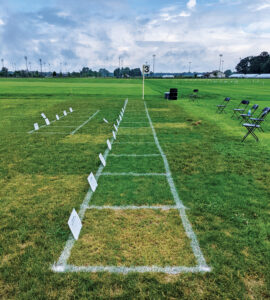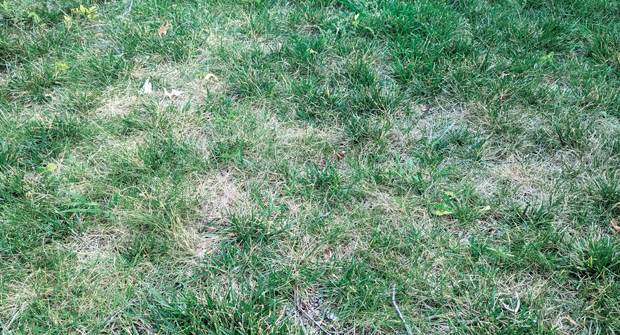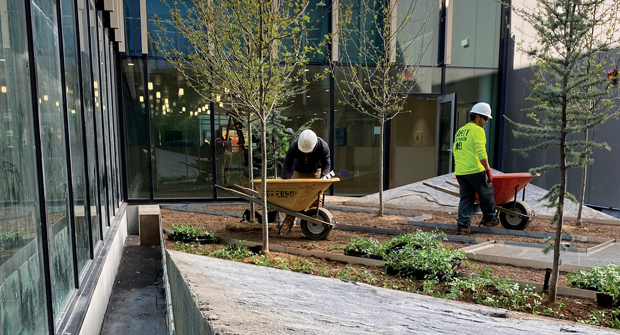The dog days of summer are inevitable. They bring high temperatures and heat-stressed turf. The latter is often accompanied by complaints from residential and commercial clients about unsightly brown grass.
Before lawn care operators can begin remedying this issue, it is essential to determine whether heat stress is the cause. According to turf professionals, misdiagnosis is common. Heat stress, most prevalent in cool-season grasses, presents symptoms similar to fungal diseases such as brown patch and drought. Not understanding the root cause of the problem often leads to ineffective management strategies.
A key heat stress indicator includes leaf chlorosis, which is a noticeable yellowing of the plant tissue, and a progressive reduction in shoot density, leading to a thinning of the turf canopy over time, says Ross Braun, Ph.D., assistant professor of turfgrass and landscape management and the director of the Rocky Ford Turfgrass Research Center at Kansas State University.
A less obvious indicator is the root dieback occurring below the surface, resulting in an underdeveloped root system that further weakens the plant, Braun says.
“The turf is unable to keep up with the photosynthesis,” Braun says. “It’s not making enough energy (compared to) the energy that it’s using, and it’s not forming new roots. It’s unable to keep up with growth, and you start having that thinned-out yellowing turf appearance.”
Turf experts outline several proactive and reactive actions that landscape and lawn care professionals can consider to reduce the impact of heat stress.
Gauge soil temperatures
As summer progresses into the peak heat of July and August, soil temperatures have a direct impact on root health. And just as turfgrass shoots have an optimal air temperature range for growth, their roots also thrive within specific soil temperature parameters.
According to turf experts, popular cool-season grasses such as tall fescue, Kentucky bluegrass and perennial ryegrass possess a lower optimal growing temperature range. Consequently, these turf varieties experience stress once air temperatures consistently exceed 85 degrees F. Conversely, warm-season grasses like Bermudagrass and zoysia don’t begin to stress until air temperatures reach 100 degrees F.
Stress further intensifies for cool-season grasses when mid-summer’s nighttime cooling is minimal. The lack of respite from the heat exacerbates the physiological strain on these grasses, Braun says.
Consequently, turf managers often rely solely on air temperature as an indicator of stress. However, by the time foliar symptoms manifest in turfgrass, their roots may have already begun to decline, hindering the plant’s ability to cool itself and absorb nutrients efficiently, says Michelle DaCosta, Ph.D., chief undergraduate adviser of turfgrass science and management and associate professor of turfgrass physiology at the University of Massachusetts Amherst.
“It’s important for turf managers to start to understand, as we’re going into these periods, what the general soil temperatures are,” DaCosta says. “If we see soil temperatures that are increasing above 75 to 80 degrees, that starts to tell us we’re getting into a period where the roots are not as efficient as they are if temperatures were below that.”
DaCosta recommends that turf managers invest in soil temperature gauges — around $200 for a pro-grade digital model — to track these trends, especially for properties with chronic heat stress issues.
Water: Too much of a good thing
Managing heat stress is not solely about monitoring temperature but also understanding the complex interaction with soil-water dynamics. Poorly drained soils, common in general landscapes and residential properties, tend to warm gradually but cool even more slowly.
DaCosta says this interplay between ambient temperature and soil moisture creates a delicate balance impacting heat stress.
“You have to find the sweet spot. You need water, of course, because you want to prevent drought stress,” she says. “But if the soil is not draining, it’s going to hold on to the heat longer, which is something (turf managers) don’t often think about.”
A common misconception is that increasing irrigation alleviates heat stress. However, Braun says excessive watering compounds the problem. Saturated soil restricts the oxygen available to roots, which, like the above-ground portions of the plant, require air for respiration. When high soil temperatures combine with waterlogged conditions, the effects of heat stress significantly amplify, causing more harm than good.
Encouraging robust root development early in the season is critical for turf varieties facing summer heat, says Jack Fry, Ph.D., professor and commercial turf extension specialist in the Department of Horticulture and Natural Resources at Kansas State University.
While spring brings ample rainfall, many regions experience significant dry periods by mid-summer. To capitalize on this, Fry recommends a specific irrigation approach: In late spring, apply a substantial amount of water, but then allow the soil to dry until the turf exhibits signs of stress before the next deep irrigation.
“This is going to enhance root development,” Fry says. “If you’re irrigating frequently, you’re going to have a shallow root, and you’re going to be encouraging more upward plant development rather than deep root development.”
Go on the offensive
Rather than solely reacting to visible symptoms, turf experts say proactive management is another key to mitigating summer heat stress.
Fry advises turf managers to emphasize the importance of routine soil testing for homeowners and property managers. Checking pH, phosphorus and potassium levels every few years provides valuable insights into the soil’s nutritional status, and any deficiencies can be addressed.

Braun advises that fall fertilization, with a focus on nitrogen, supports robust top growth and root development before the onset of summer stress.
“Essentially, if you have more vegetation on the top, and you have a deeper root system on the bottom, then you’re going to be in the best position to tolerate those really stressful summer periods of heat stress,” he says.
Interestingly, Fry says recent research at Kansas State has revealed certain slow-release nitrogen sources can, surprisingly, contribute to higher levels of brown patch disease in tall fescue, similar to the effects of quick-release urea. Therefore, Fry warns that while practical nitrogen application is important, turf managers working with tall fescue in hot, humid summer conditions also should consider the proactive use of fungicides to minimize brown patch outbreaks.
“It’s good to put effective nitrogen out,” Fry says. “But if you’re dealing with tall fescue, and you get a lot of rain and you have heat, you may need a fungicide to minimize any brown patch during the summer months.”
Cultural practices such as core aeration, ideally performed in the fall or early spring to allow for turf recovery, are vital for alleviating soil compaction and improving air and water movement, fostering deeper root systems that enhance overall summer heat resistance resilience. Fry recommends utilizing a solid or thin tine if aeration is performed during the summer to increase airflow through a dense soil profile and minimize further damage to already stressed turf.
Turf experts advise maintaining a higher mowing height year-round, which is another critical strategy. “Time and time again, the research shows the benefits of higher mowing heights,” Fry says. “Even raising the mowing height up a half inch is going to help and may not even be noticeable to customers.”
Finally, advising clients to limit foot traffic and activity on the turf during periods of peak heat stress, while often impractical and difficult to enforce, will limit damage and aid recovery.


